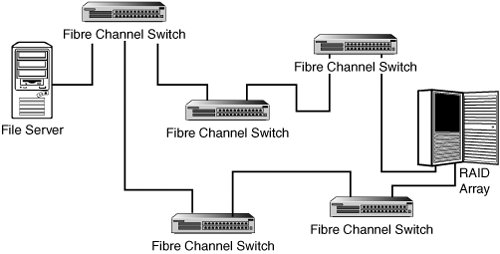Using a Fabric Switched Topology for SANs
| As you just learned, an Arbitrated Loop uses a physical ring topology and is usually wired by a hub. The hub simply maintains the physical loop topology, as with a Token-Ring network. A hub can, however, do such things as remove a misbehaving port from the physical ring, or insert a new device into the physical ring. A switch can perform similar functions, among many others. The main limitations of the Arbitrated Loop versus fabric switches is that the loop allows only one communication session to take place at a point in time between members of the loop, and is limited to 126 member nodes. Note It's not an all-or-nothing proposition. You can use both Arbitrated Loops and fabric switches at the same time. Remember that Arbitrated Loops can use that 127th connection to make contact with a fabric switch. You'll learn more about this subject later in this chapter. However, the switch has now become an important player in the SAN environment, mainly due because the switch offers more features than an Arbitrated Loop, and by interconnecting switches you can create a much larger SAN network, and a much greater bandwidth. The 126-node limit is gone when it comes to switchesfabrics can support up to 15.5 million end nodes! To make a comparison with Ethernet again, consider switches to perform a similar function when switching data in one port and out the other. However, when it comes to how devices interact with switch ports, and perform login procedures with both switch ports and remote ports, things get more complicated. The switch gets rid of having to pass data around a ring until one node decides it needs to send data frames. Instead, like Ethernet, Fibre Channel frames are sent out as needed. This means that switches keep some sort of routing table so that they know what the output port should be. In this way, they work like routers. The switch can transmit many frames at the same time, between various ports, or buffer those that can wait for a short period. Because a switch may be connected to another switch, and so on, you can see that some sort of setup is needed before this data transfer can begin. See Figure 11.4 for an example. Figure 11.4. Fibre Channel fabric switches greatly expand the size of the SAN. Figure 11.4 shows only two possible paths through the network between the file server and the disk array. In actual practice many switches can be interconnected, providing additional paths through the network, thus helping to keep downtime to a minimum. A connection must be made between the end points of the data transfer before the transfer through the switched network can begin. Two forms of logins are used by Fibre Channel: Fiber Login (FLOGI) and Port Login (PLOGI). A port, if connected directly to a switch, must first log on to the switch. Then it can log on to ports on other devices it needs to make a connection with. The FLOGI sequence is tried first, because a device needs to know first if it is connected to a fabric switch before it begins to log into ports it will interact with. If the FLOGI fails, the node will proceed with a port login and attempt to create a login exchange with other ports it will be exchanging data with. This is what happens on an Arbitrated Loop and the LIPs that initialize the loop. If the FLOGI succeeds, the device or port knows that it has performed a login with a fabric switch port. In this case the PLOGI login sequence continues so that the switch can establish PLOGI logins with the ports (which may be several switches away), and the communication can proceed. Another factor to note is that there are several categories of service associated with Fibre Channel. The fastest connection, Class One, is set up by the intervening switches as a dedicated pathway. Other classes offer a lower service, but the technology is still faster than typical IP or other protocols for fast service. Note One important thing to note is that a port may be establishing connections to other ports, and each connection may be of a different class of service. All of these parameters are negotiated, depending on the capabilities of the ports, during FLOGI and PLOGI. The classes of service for Fibre Channel are as listed here:
A very important factor to consider when purchasing SANs equipment is what class of service you need, and whether the switch supports that class. Most switches do not support all the classes of service. It is more likely that you'll find only two or three classes of service. On lower-end switches, for example, Class One service may not be available, although Class Two and Class Three are. Another interesting factor to note is that there is no Class Five. This is because this class was originally supposed to be used for a just-in-time isochronous service. This was intended to provide data at a continuous rate to a receiver so that no buffering at the receiver was needed. Compare this to the radio in your car. The radio station broadcasts at a specific rate, and your radio processes this incoming signal at the same rate. For computer networks, an example of this would be an application such as video transmissions. However, as newer equipment was able to transfer data at faster rates, and as buffering technology improved, it was determined that this class of service was not needed. |
EAN: 2147483647
Pages: 411
